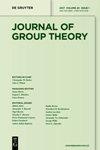关于Higman-Thompson群的一族表示
IF 0.5
3区 数学
Q4 MATHEMATICS
引用次数: 2
摘要
摘要我们得到了Higman-Thompson群F n∧T n∧V n F_{n}\子集T_{n}\子集V_{n}的不可数不等式和不可约表示族。这是通过考虑由Cuntz代数表示产生的Higman-Thompson群V n V_{n}的一系列表示来实现的,每个表示作用于希尔伯特空间,该空间建立在点x∈[0,1)x\in[0,1)的轨道上,在动力系统Φ (x)=n (x) \Phi(x)=nx\pmod{1}下。通过V n V_{n}对orb (x) \算子名{orb}(x)的作用来检索每一个这样的表示,并利用群的性质研究了它们对V n V_{n}的子群F n F_{n}和T n T_{n}的限制。本文章由计算机程序翻译,如有差异,请以英文原文为准。
On a family of representations of the Higman–Thompson groups
Abstract We obtain an uncountable family of inequivalent and irreducible representations of the Higman–Thompson groups F n ⊂ T n ⊂ V n F_{n}\subset T_{n}\subset V_{n} . This is accomplished by considering a family of representations of the Higman–Thompson groups V n V_{n} that arise from representations of Cuntz algebras, each one acting on a Hilbert space built upon the orbit of a point x ∈ [ 0 , 1 ) x\in[0,1) under the dynamical system Φ ( x ) = n x ( mod 1 ) \Phi(x)=nx\pmod{1} . Every such representation is retrieved through the action of V n V_{n} on orb ( x ) \operatorname{orb}(x) , and their restrictions to the subgroups F n F_{n} and T n T_{n} of V n V_{n} are studied using properties of the groups.
求助全文
通过发布文献求助,成功后即可免费获取论文全文。
去求助
来源期刊

Journal of Group Theory
数学-数学
CiteScore
1.00
自引率
0.00%
发文量
45
审稿时长
6 months
期刊介绍:
The Journal of Group Theory is devoted to the publication of original research articles in all aspects of group theory. Articles concerning applications of group theory and articles from research areas which have a significant impact on group theory will also be considered.
Topics:
Group Theory-
Representation Theory of Groups-
Computational Aspects of Group Theory-
Combinatorics and Graph Theory-
Algebra and Number Theory
 求助内容:
求助内容: 应助结果提醒方式:
应助结果提醒方式:


